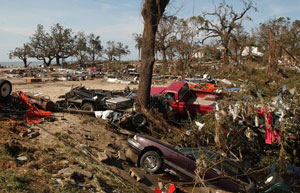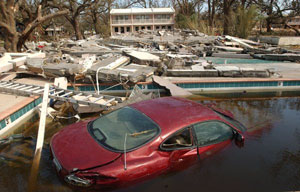 |
 | ||||||||||
Katrina Journal
|
 |
|||||||||
|
"I'm afraid this one's headed for us."
Those words, spoken by our publisher, Ricky Mathews, on the Saturday before Hurricane Katrina made landfall, chilled me. Mathews had called a meeting of the entire Sun Herald newsroom to tell us how concerned he was that this hurricane would deliver a catastrophic blow to the Mississippi Gulf Coast. An experienced deep-sea fisherman, Matthews' sources on weather blogs and his own intuition told him the storm was turning north, right for us. That's when I got scared.
I was really worried about our house and possibly losing the roof. I lived near a bayou, but the thought of water getting that high never crossed my mind. I didn't live in a flood zone so I never thought about getting flood insurance.
Saturday night in the shelter - a high school - was better than I expected. I was placed in the library with the deputies and military personnel; it was air-conditioned and a lot quieter. I even had a cot. I got busy shooting the storm refugees lining the hallways, making do as best they could, and borrowed a phone line in the Red Cross office to send the photos to our Web site.
By late Sunday afternoon, the winds had died down enough for me to attempt to make it home. A neighbor who had gone to the shelter with me was desperate for news of his pregnant wife, who was a nurse at the hospital in Ocean Springs. I told him that I'd try to make it home and if it were safe, I'd come back for him and his son. I had to go a long way around to avoid flooded roads, downed trees, and lines, stopping to shoot the damage along the way. But I made it just before dark on Sunday.
As I pulled onto my street, I could see I had lost most of the siding on one side of the house, but the roof was on and otherwise the house looked intact. I unlocked the door and stepped inside to find everything as I left it, only the carpet was wet. A little siding, some new carpet, and it will be good as new. Or so I thought. I drove back to the shelter and my neighbor and I packed up, ready to head back to our houses. Then a deputy stopped us at the door and said no one was going anywhere. A curfew was in effect, and if we left, we'd be arrested.
I didn't expect there to be a Sun Herald building anymore. Everything along the beach was gone, and our offices are just a quarter-mile off the beach. I was relieved when I finally saw our building: at least something survived.
Three photographers were already there working. Nick Oza, from the Macon Telegraph, Patrick Schneider, from the Charlotte Observer, and Gary Reyes, of the San Jose Mercury News had been sent by our parent company, Knight-Ridder, to assist us in covering the aftermath. For the first two days, the four of us shot everything for the paper. My staff was trying to get back in town, but it would be a few days before they were able to get back to the Coast. But soon photographers from other Knight-Ridder papers arrived, and I found myself managing a staff of 10 photographers.
We slept on the floor of conference rooms and the library at the paper. We had food, mostly canned tuna and chicken. The day began at 7 a.m., and ended for me around 10 or 11p.m. We had a general newsroom meeting at 7 a.m. and another meeting for page one around 2 p.m. Those first two weeks are just a blur. I had to keep asking people what day it was. I simply lost track of time.
Our generator couldn't run the presses so the big question was how to produce the newspaper. We sent a team of designers and editors to a sister paper in Columbus, Ga., and transmitted stories and photos via satellite phone to Georgia, where the paper was designed and printed and then trucked to us in Mississippi. It was a long, complicated process but we never missed a single day of publication.
The support we received from Knight-Ridder was amazing. Besides the reporters, editors and photographers sent to assist us, they rented every motor home they could find and drove them down to our plant for us to stay in. At one time there were close to 30 motor homes crowding the parking lot.
When I finally had time to go home, I was shocked at what had happened to my house. As soon as I opened the door, the stench hit me. Then I saw the mold. It was already crawling up the walls, and was covering parts of the living room furniture. But the smell was the worst part. The bayou water that had flooded the neighborhood had backed up the sewer systems, carrying raw sewage with it. The house now smelled like a sewer. Fortunately, the upstairs rooms were unaffected.
So I began life as a hurricane refugee.
About a week after the storm, my wife called from Florida to say she'd had enough of me putting my job first. She asked for a divorce and now we're living apart. I stayed for a while in an apartment supplied by the paper but I have since moved back home. All the wet carpet and drywall have been removed, along with the ruined cabinets. I missed being home, and I'm staying upstairs in my girls' old rooms. I missed being home and a half-ruined house is better than none at all.
We are adjusting now, getting used to the 'new normal' of curfews, armed soldiers at intersections, long lines everywhere, and a nuclear landscape. There is a fear, however, that the terrible destruction here is being overlooked in the aftermath of the flooding and evacuation of New Orleans.
I know that this storm has been the seminal point in my life, both personally and professionally. It is the biggest story I've ever been a part of and the one that has affected me the most. I hope and pray it remains that way.
© Drew Tarter
Photo Director, The Sun Herald, Biloxi, Mississippi
Dispatches are brought to you by Canon. Send Canon a message of thanks. |
||||||||||
Back to October 2005 Contents
|
|



